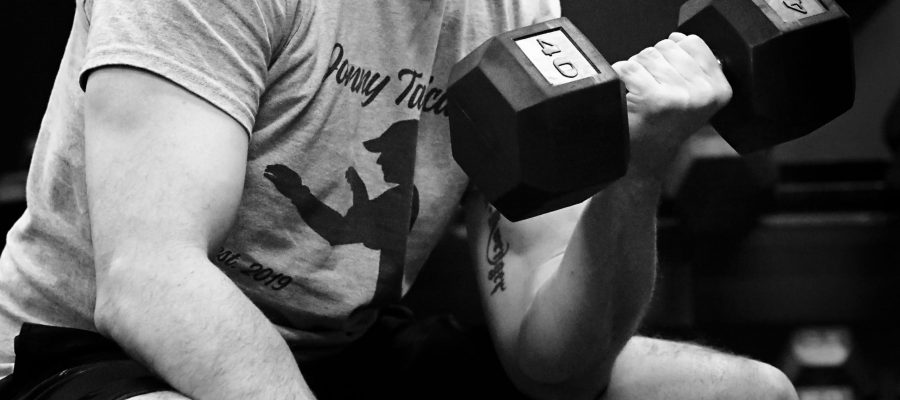I’ve been skinny my whole life. If I turned sideways and stuck out my tongue, I looked like a zipper. Heck, I had to run laps in the shower just to get wet. I hated being called skinny like fat people hated being called fat. To me, skinny equaled weak, and I didn’t want to be weak or even perceived as weak. Call it ego. Call it insecurity. Whatever. That’s just the way it was.
I played sports as a kid, did martial arts, and ate adequately, but I couldn’t gain an ounce. (And don’t give me that sarcastic, “I wish I had that problem,” or, “It must be nice,” while you tilt your head and offer a fake sympathetic look, because I will punch you right in the pants!).
Searching For Answers
Interestingly, I learned an alternate term for a skinny guy: “hard-gainer.” As in, it’s hard to gain weight. Hard-gainer sounds way tougher, at least when compared to “string bean.” So, feeling slightly better about myself with my new hard-gainer identity, I searched for answers to build muscles like you read about.
A couple years ago (as a thirty-something) I started doing Crossfit-esque workouts and gained about ten pounds of what I like to think of as “muscle.” But at 6’01” I couldn’t break the 200 pound threshold that I had artificially established for myself. I had made progress putting on some weight and gaining strength, but before long I hit the dreaded plateau.
Occam’s Protocol
So, I started reading blogs and articles on building muscle, but nothing I tried ever seemed to work for me. While reading books in the self-improvement space, I came across the best-selling author, Tim Ferriss. I read his book Tools of Titans and was completely hooked on the content. That book led me to an earlier work written by Tim called The 4-Hour Body: An Uncommon Guide To Rapid Fat-Loss, Incredible Sex, And Becoming Superhuman1.
The 4-Hour Body has two chapters in it called Occam’s Protocol I and Occam’s Protocol II (pp. 193 – 224) which pretty much knocked me sideways. The basic premiss of Occam’s Protocol comes from Occam’s Razor by William of Occam (c. 1288 – 1348) which says, “It is vain to do with more what can be done with less.” In other words, less is more or eliminate the unnecessary. How does that apply to weight gain? Do less, get more. Pretty counterintuitive.
How The Workouts Work
Those two chapters outline the workouts, Workout A and Workout B. Each workout consists of only two movements and only one set of each movement. Each week, you alternate between Workout A and Workout B. As weight is added to each workout, so are the days of rest in between. Oh, and you have to eat like it’s your job. That’s about it.
I figured there was nothing for me to lose, no pun intended. I tried it for three months and put on 12 pounds! Boom. For a skinny guy like me, that was a big deal. Here’s what it looks like (I did the free weight option explained in further detail in the book):
Workout A
- All reps are done at a slow cadence of 5 seconds up / 5 seconds down
- Yates row with EZ bar x 7 reps
- Shoulder-width barbell overhead press x 7 reps
Workout B
- All reps are done at a slow cadence of 5 seconds up / 5 seconds down
- Slight incline bench press (less than 20 degrees) x 7 reps (I used dumbbells)
- Squat x 10 reps
The key to the workout is that the last repetition culminates at the point of muscular failure. Ferriss defines failure as unable to move the weight but still “pushing like you have a gun to your head.” Ferriss says, “The rest of the repetitions are just a warm up for that moment.” (p. 202)
What I Experienced
Here’s the increase in strength that I recorded:
- Yates Row – 141% increase
- Shoulder Press – 12% increase
- Squat – 39% increase
- Bench Press – 31% increase
Why the big increase in the Yates Row and such a marginal increase in the Shoulder Press? Well, I could have started with weight inordinately low on the Yates Row and maybe too high on the Shoulder Press. Or I could just have wimpy shoulders. It’s probably a little of both. The bottom line is, I experienced an increase in weight and an overall increase in strength. For me, that’s a win.
I experienced the sense that I needed to do more in the gym, which, Ferriss says, is normal, just don’t do it. I also experienced a light-headed feeling after the last rep, some dizziness, and the weirdest sense of being completely gassed. When it was over, I would slowly waddle out of the gym like a geriatric penguin. It was such a different feeling from my usual workouts. I don’t know how to explain it, it was just different.
If you’re a hard-gainer like me and want to put on some poundage, want to bulk up for football, or just want to try something different, go for it! Pick up The 4-Hour Body and get all the details you need to get started.
Tactical Disclaimer
Allow me to remind you that I am not a doctor and I don’t play one on TV. Do additional research and talk to your doctor before doing anything. Don’t do something stupid and hurt yourself. That would not be very tactical.
_____________________
- Are you stuck in a workout rut or have hit a plateau?
- Are you ready to try something new?
- What is stopping you?
1. Ferriss, Timothy. The 4-Hour Body: An Uncommon Guide To Rapid Fat-Loss, Incredible Sex, And Becoming Superhuman (New York: Crown Archetype, 2010), pp. 193-224.



Leave a Reply
Your email is safe with us.
You must be logged in to post a comment.